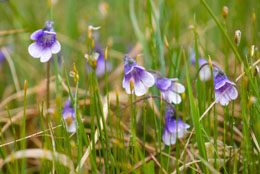The butterwort plant is a carnivore which feeds on insects. Butterwort in the house can have a dual advantage - one keeping the house insect-free and the other adding beauty to the room it is placed in...

Have you ever come across a plant that actually
eats meat? Plants and meat - two poles apart, but it's not something out of fiction. There are some species of plants that feast on insects to suffice their nutrient requirements. Such plants are known as insectivores or plants that feed on insects. These carnivorous plants grow in swampy soil which are very low in nitrogen content, required for the growth and development of the plant. Hence, these plants trap insects, whose bodies are rich in nitrates, and fulfill their requirements. One such carnivorous plant is the butterwort plant, which is found in the continents of Europe, Northern Asia and North America. Some of the species of this plant can also be seen in Central and South America.
Butterwort Facts
As mentioned earlier, butterwort is an insectivorous plant which feeds on live insects and arachnids. There are many more amazing facts about this insect catching plant, a few of which are mentioned below.
- The botanical name of the butterwort is Pinguicula, which in Latin means 'sticky or buttery leaf'. This name was coined by a botanist, Conrad Gesner, in the year 1561 because of the characteristic nature of the plant. These are perennial plants belonging to the family Lentifbulariaceae.
- There are around twelve species of butterworts which can also survive in high altitude terrains having rocky soil and very cold temperatures.
- The plant has brightly colored flowers and sticky leaves. The leaves have tiny hair like structures on their surface and have mucus like secretions, to trap insects. The leaves are succulent and give out a musty smell that attracts insects.
- This carnivorous plant 'feasts' on spiders, slugs, flies, caterpillars and crickets. The insects get lured to the bright colors and land on them, unaware that they will be eaten up in a few minutes. Once the insect lands on the leaf, it gets trapped. The leaf then closes completely further trapping the insect. The juices secreted in the leaves completely digests the insect.
- A particular species of butterworts, Pinguicula vulgaris, can be grown in homes, greenhouses and nurseries. These potted plants grow well with proper care. However, these plants are also attacked by pests and diseases. The butterwort is prone to crow rot disease and nematodes, which are a type of indoor plant bugs, that can destroy the plants.
Butterwort Care
Butterwort is a popular houseplant that can add color and vitality to a room. These unique and interesting plants can be grown in pots.
- Butterworts are acidic soil plants that flourish well in an acidic and well drained soil. The pot must contain a mixture of sphagnum moss, sand and peat moss. Keep the potted plant is bright and well filtered light. Never expose your plant to direct and intense sunlight as it can damage the leaves.
- Use only distilled water for your butterwort. Tap water contains salts and chemicals that can destroy the plant. Rainwater is also excellent for the thriving of this plant. Never be overenthusiastic in watering your butterwort, as too much water lead to the decaying of the roots, which in turn may destroy the plant. Water the plant once a week and drain out the excess water. Keeping the soil moist is also another important factor to be remembered.
- These indoor plants grow well in a humid environment and the room temperature must be approximately 55 to 85 degrees Fahrenheit. During the winter season, these plants go into a state of dormancy, hence frequent watering is not necessary. But make sure that the soil is slightly moist to avoid complete drying of the plant.
- Like all other indoor plants, butterworts may also get infested with bacterial or fungal growth. Clipping the diseased leaves can prevent the spread of infestation and make sure the plant is healthy throughout.
The butterwort plant can flourish well in homes, if its basic requirements of soil, fertilizer and temperature are taken care of. Growing butterworts in the house will ensure that your home is free from bothersome mosquitoes and flies.






 Have you ever come across a plant that actually eats meat? Plants and meat - two poles apart, but it's not something out of fiction. There are some species of plants that feast on insects to suffice their nutrient requirements. Such plants are known as insectivores or plants that feed on insects. These carnivorous plants grow in swampy soil which are very low in nitrogen content, required for the growth and development of the plant. Hence, these plants trap insects, whose bodies are rich in nitrates, and fulfill their requirements. One such carnivorous plant is the butterwort plant, which is found in the continents of Europe, Northern Asia and North America. Some of the species of this plant can also be seen in Central and South America.
Have you ever come across a plant that actually eats meat? Plants and meat - two poles apart, but it's not something out of fiction. There are some species of plants that feast on insects to suffice their nutrient requirements. Such plants are known as insectivores or plants that feed on insects. These carnivorous plants grow in swampy soil which are very low in nitrogen content, required for the growth and development of the plant. Hence, these plants trap insects, whose bodies are rich in nitrates, and fulfill their requirements. One such carnivorous plant is the butterwort plant, which is found in the continents of Europe, Northern Asia and North America. Some of the species of this plant can also be seen in Central and South America.